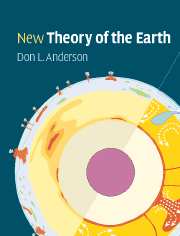Book contents
- Frontmatter
- Contents
- Preface and Philosophy
- Abbreviations and acronyms
- Part I Planetary perspective
- Part II Earth: the dynamic planet
- Part III Radial and lateral structure
- Chapter 8 Let's take it from the top: the crust and upper mantle
- Chapter 9 A laminated lumpy mantle
- Chapter 10 The bowels of the Earth
- Chapter 11 Geotomography: heterogeneity of the mantle
- Part IV Sampling the Earth
- Part V Mineral physics
- Part VI Origin and evolution of the layers and blobs
- Part VII Energetics
- References and notes
- Appendix
- Index
Chapter 8 - Let's take it from the top: the crust and upper mantle
Published online by Cambridge University Press: 05 June 2012
- Frontmatter
- Contents
- Preface and Philosophy
- Abbreviations and acronyms
- Part I Planetary perspective
- Part II Earth: the dynamic planet
- Part III Radial and lateral structure
- Chapter 8 Let's take it from the top: the crust and upper mantle
- Chapter 9 A laminated lumpy mantle
- Chapter 10 The bowels of the Earth
- Chapter 11 Geotomography: heterogeneity of the mantle
- Part IV Sampling the Earth
- Part V Mineral physics
- Part VI Origin and evolution of the layers and blobs
- Part VII Energetics
- References and notes
- Appendix
- Index
Summary
ZOE: Come and I'll peel off.
BLOOM: (feeling his occiput dubiously with the unparalleled embarrassment of a harassed pedlar gauging the symmetry of her peeled pears) Somebody would be dreadfully jealous if she knew.
James Joyce, UlyssesThe broad-scale structure of the Earth's interior is well known from seismology, and knowledge of the fine structure is improving continuously. Seismology not only provides the structure, it also provides information about the composition, mineralogy, dynamics and physical state. A 1D seismological model of the Earth is shown in Figure 8.1. Earth is conventionally divided into crust, mantle and core, but each of these has subdivisions that are almost as fundamental (Tables 8.1 and 8.2). Bullen subdivided the Earth's interior into shells, from A (the crust) through G (the inner core). The lower mantle, starting at 1000 km depth, is the largest subdivision, and therefore it dominates any attempt to perform major-element mass balance calculations. The crust is the smallest solid subdivision, but it has an importance far in excess of its relative size because we live on it and extract our resources from it, and, as we shall see, it contains a large fraction of the terrestrial inventory of many elements.
The crust
The major divisions of the Earth's interior – crust, mantle and core – have been known from seismology for about 80 years. These are based on the reflection and refraction of P- and S-waves.
- Type
- Chapter
- Information
- New Theory of the Earth , pp. 91 - 108Publisher: Cambridge University PressPrint publication year: 2007



